Organisational Structure
Organisational structure is concerned with the way in which work is divided up and allocated, and how co-ordination to achieve objectives is achieved.
It outlines the roles and responsibilities of individuals and groups within an organisation
Types of organisational structure
A typical pattern of structural change can be represented by the following sequence.
Entrepreneurial
- An entrepreneurial structure is built around the owner manager and is typical of small companies in the early stages of their development.
- The entrepreneur often has specialist knowledge of the product or service
- Example owner/managed business
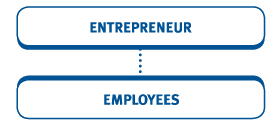
Functional
- A functional structure is common in organisations that have outgrown the entrepreneurial structure and now organise the business on a functional basis.
- It is most appropriate to small companies which have few products and locations and which exist in a relatively stable environment.
- For example a business making one type of electrical component for use in a car manufacturing company.

Divisional
Some organisations are structured in accordance with product lines or
divisions or departments.
- They are headed by general managers who enjoy responsibility for their own resources.
- Divisions are likely to be seen as profit centres and may be seen as strategic business units for planning and control purposes.
- Some departments, e.g. accounts will be centralised.
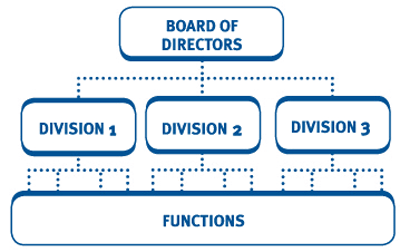
Matrix
A
matrix structure aims to combine the benefits of decentralisation (e.g. speedy decision making) with those of co-ordination (achieving economies and synergies across all business units, territories and products).
It usually requires employees from various departments to form a group to achieve a specific target.
They require dual reporting to managers and the diagram shows a mix of product and functional structures.
For example in a university, a lecturer may have to report to both subject and department heads.
A matrix structure aims to combine the benefits of decentralisation (e.g. speedy decision making) with those of co-ordination (achieving economies and synergies across all business units, territories and products).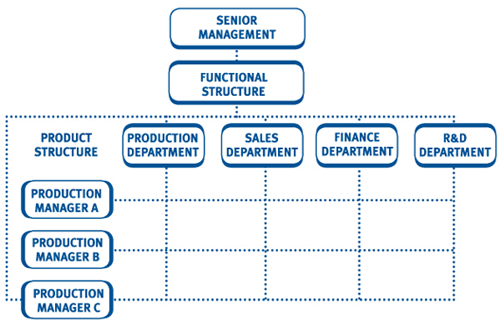
Tall and flat organisations
Some definitions
Scalar chain
This is defined as the line of authority which can be traced up or down the chain of command, and thus relates to the number of management levels within an organisation.
Span of control
A manager's span of control is the number of people for whom he or she is directly responsible.
Tall and flat organisations
A tall structure has many managerial levels (hierarchies) and a 'narrow' span of control.
A flat structure has few managerial levels and a 'wide' span of control.
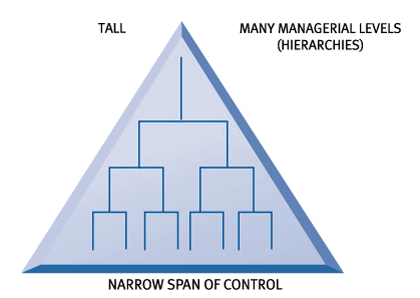
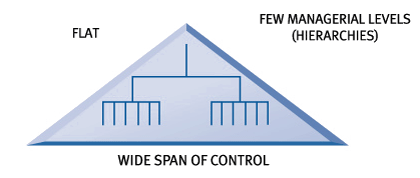
The factors that influence the span of control
The factors that influence the span of control include:
- nature of the work - the more repetitive the work, the wider the span of control
- type of personnel - the better managers and personnel are, the wider the span of control
- location of personnel - the more widely spread the personnel the narrower the span of control.
Centralisation and decentralisation
Another method of analysing structures is by reference to the level at which decisions are made.
- In a centralised structure, the upper levels of an organisation's hierarchy retain the authority to make decisions.
- In a decentralised structure the authority to take decisions is passed down to units and people at lower levels.
The factors that will affect the amount of decentralisation are:
- Management style.
- Ability of management/employees.
- Locational spread.
- Size of the organisation/scale of activities.
The advantages and disadvantages of decentralisation are:
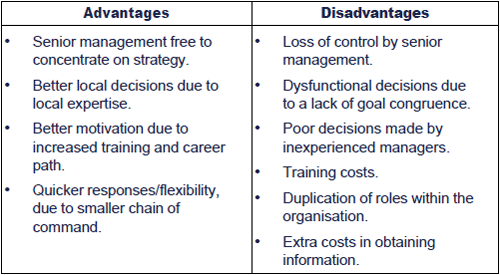
Informal organisation
So far, we have been looking at formal organisational structures - they have been designed by management to try and ensure that an organisation can meet its goals.
Informal organisation evolves over time and is a network of relationships that exist within an organisation. The relationships arise due to common interests or friendships. These relationships can be across divisions and it is through these relationships that daily interactions between members of staff take place.
Within a formal organisation, an informal organisation will be present and all organisations have some mix of the two.
For further discussion of informal organisation, click here.
Further detail and related topics
Further details on topics related to organisational structure can be accessed by clicking on the following links:
- Entrepreneurial structures in more detail - pros, cons, etc
- Functional structures in more detail - pros, cons, etc
- Divisional structures in more detail - pros, cons, etc
- Matrix structures in more detail - pros, cons, etc
- Informal organisation in more detail - pros, cons, etc
- Organisational flexibility
- Organisational culture
|
Created at 6/19/2012 4:20 PM by System Account
(GMT) Greenwich Mean Time : Dublin, Edinburgh, Lisbon, London
|
Last modified at 9/24/2013 4:06 PM by System Account
(GMT) Greenwich Mean Time : Dublin, Edinburgh, Lisbon, London
|
|
|
|
 |
Rating
:
|
 Ratings & Comments
(Click the stars to rate the page) Ratings & Comments
(Click the stars to rate the page)
|
 |
Tags:
|
|
|
|
|